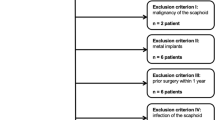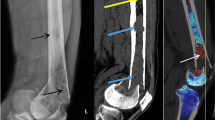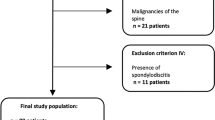Abstract
Objectives
To evaluate the diagnostic accuracy of dual-energy computed tomography (CT) virtual non-calcium (VNCa) reconstructions for the depiction of traumatic knee bone marrow edema.
Methods
Fifty-seven patients (mean age, 50 years; range, 20–82 years) with acute knee trauma further divided into 30 women and 27 men, who had undergone third-generation dual-source dual-energy CT and 3-T magnetic resonance imaging (MRI) within 7 days between January 2017 and May 2018, were retrospectively analyzed. Six radiologists, blinded to clinical and MRI information, independently analyzed conventional grayscale dual-energy CT series for fractures; after 8 weeks, readers evaluated color-coded VNCa reconstructions for the presence of bone marrow edema in six femoral and six tibial regions. Quantitative analysis of CT numbers on VNCa reconstructions was performed by a seventh radiologist. Two additional radiologists, blinded to clinical and CT information, analyzed MRI series in consensus to define the reference standard. Sensitivity, specificity, and the area under the curve (AUC) were the primary metrics of diagnostic accuracy.
Results
MRI revealed 197 areas with bone marrow edema (91/342 femoral, 106/342 tibial). In the qualitative analysis, VNCa showed high overall sensitivity (1108/1182 [94%]) and specificity (2789/2922 [95%]) for depicting bone marrow edema. The AUC was 0.96 (femur) and 0.97 (tibia). A cutoff value of − 51 Hounsfield units (HU) provided high sensitivity (102/106 [96%]) and specificity (229/236 [97%]) for differentiating tibial bone marrow edema.
Conclusions
In both quantitative and qualitative analyses, dual-energy CT VNCa reconstructions yielded excellent diagnostic accuracy for depicting traumatic knee bone marrow edema compared with MRI.
Key Points
• Dual-energy CT (DECT) virtual non-calcium (VNCa) reconstructions are highly accurate in depicting bone marrow edema of the femur and tibia.
• Diagnostic confidence, image noise, and image quality were rated as equivalent in VNCa reconstructions and MRI (magnetic resonance imaging) series.
• VNCa images may serve as an alternative imaging approach to MRI.






Similar content being viewed by others
Abbreviations
- AUC:
-
Area under the curve
- CT:
-
Computed tomography
- HU:
-
Hounsfield unit
- MRI:
-
Magnetic resonance imaging
- MSK:
-
Musculoskeletal
- NPV:
-
Negative predictive value
- PD:
-
Proton density
- PPV:
-
Positive predictive value
- ROC:
-
Receiver operating characteristic
- ROI:
-
Region of interest
- VNCa:
-
Virtual non-calcium
References
Bretlau T, Tuxøe J, Larsen L, Jørgensen U, Thomsen HS, Lausten GS (2002) Bone bruise in the acutely injured knee. Knee Surg Sports Traumatol Arthrosc 10:96–101
Davies NH, Niall D, King LJ, Lavelle J, Healy JC (2004) Magnetic resonance imaging of bone bruising in the acutely injured knee—short-term outcome. Clin Radiol 59:439–445
Vincken PW, Ter Braak BP, van Erkel AR, Coerkamp EG, Mallens WM, Bloem JL (2006) Clinical consequences of bone bruise around the knee. Eur Radiol 16:97–107
Mandalia V, Fogg AJ, Chari R, Murray J, Beale A, Henson JH (2005) Bone bruising of the knee. Clin Radiol 60:627–636
Nakamae A, Engebretsen L, Bahr R, Krosshaug T, Ochi M (2006) Natural history of bone bruises after acute knee injury: clinical outcome and histopathological findings. Knee Surg Sports Traumatol Arthrosc 14:1252–1258
Oda H, Igarashi M, Sase H, Sase T, Yamamoto S (2008) Bone bruise in magnetic resonance imaging strongly correlates with the production of joint effusion and with knee osteoarthritis. J Orthop Sci 13:7–15
Yao L, Lee J (1988) Occult intraosseous fracture: detection with MR imaging. Radiology 167:749–751
Morsbach F, Desbiolles L, Raupach R, Leschka S, Schmidt B, Alkadhi H (2017) Noise texture deviation: a measure for quantifying artifacts in computed tomography images with iterative reconstructions. Invest Radiol 52:87–94
Mustonen A, Koskinen SK, Kiuru MJ (2005) Acute knee trauma: analysis of multidetector computed tomography findings and comparison with conventional radiography. Acta Radiol 46:866–874
Boks SS, Vroegindeweij D, Koes BW, Hunink MG, Bierma-Zeinstra SM (2006) Follow-up of occult bone lesions detected at MR imaging: systematic review. Radiology 238:853–862
Lell MM, Ruehm SG, Kramer M et al (2009) Cranial computed tomography angiography with automated bone subtraction: a feasibility study. Invest Radiol 44:38–43
Nicolaou S, Liang T, Murphy DT, Korzan JR, Ouellette H, Munk P (2012) Dual-energy CT: a promising new technique for assessment of the musculoskeletal system. AJR Am J Roentgenol 199:78–86
Mallinson PI, Coupal TM, McLaughlin PD, Nicolaou S, Munk PL, Ouellette HA (2016) Dual-energy CT for the musculoskeletal system. Radiology 281:690–707
Wichmann JL, Booz C, Wesarg S et al (2014) Dual-energy CT–based phantomless in vivo three-dimensional bone mineral density assessment of the lumbar spine. Radiology 271:778–784
Petritsch B, Kosmala A, Weng AM et al (2017) Vertebral compression fractures: third-generation dual-energy CT for detection of bone marrow edema at visual and quantitative analyses. Radiology 284:161–168
Kaup M, Wichmann JL, Scholtz JE et al (2016) Dual-energy CT–based display of bone marrow edema in osteoporotic vertebral compression fractures: impact on diagnostic accuracy of radiologists with varying levels of experience in correlation to MR imaging. Radiology 280:510–519
Wang CK, Tsai JM, Chuang MT, Wang MT, Huang KY, Lin RM (2013) Bone marrow edema in vertebral compression fractures: detection with dual-energy CT. Radiology 269:525–533
Kosmala A, Weng AM, Heidemeier A et al (2017) Multiple myeloma and dual-energy CT: diagnostic accuracy of virtual noncalcium technique for detection of bone marrow infiltration of the spine and pelvis. Radiology 286:205–213
Frellesen C, Azadegan M, Martin SS et al (2018) Dual-energy computed tomography-based display of bone marrow edema in incidental vertebral compression fractures: diagnostic accuracy and characterization in oncological patients undergoing routine staging computed tomography. Invest Radiol 53:409–416
Pache G, Krauss B, Strohm P et al (2010) Dual-energy CT virtual noncalcium technique: detecting posttraumatic bone marrow lesions—feasibility study. Radiology 256:617–624
Albrecht MH, Trommer J, Wichmann JL et al (2016) Comprehensive comparison of virtual monoenergetic and linearly blended reconstruction techniques in third-generation dual-source dual-energy computed tomography angiography of the thorax and abdomen. Invest Radiol 51:582–590
Müller ME, Koch P, Nazarian S et al (1990) Tibia/fibula = 4. In: Müller ME, Nazarian S, Koch P, Schatzker J (eds) The comprehensive classification of fractures of long bones. Springer-Verlag Berlin Heidelberg, pp 148–191
Genders TS, Spronk S, Stijnen T, Steyerberg EW, Lesaffre E, Hunink MG (2012) Methods for calculating sensitivity and specificity of clustered data: a tutorial. Radiology 265:910–916
Landis JR, Koch GG (1977) The measurement of observer agreement for categorical data. Biometrics 55:159–174
Ai S, Qu M, Glazebrook KN et al (2014) Use of dual-energy CT and virtual non-calcium techniques to evaluate post-traumatic bone bruises in knees in the subacute setting. Skeletal Radiol 43:1289–1295
Cao JX, Wang YM, Kong XQ, Yang C, Wang P (2015) Good interrater reliability of a new grading system in detecting traumatic bone marrow lesions in the knee by dual energy CT virtual non-calcium images. Eur J Radiol 84:1109–1115
Sanders TG, Medynski MA, Feller JF, Lawhorn KW (2000) Bone contusion patterns of the knee at MR imaging: footprint of the mechanism of injury. Radiographics 20:135–151
Laor T, Jaramillo D (2009) MR imaging insights into skeletal maturation: what is normal? Radiology 250:28–38
Vogler JB 3rd, Murphy WA (1988) Bone marrow imaging. Radiology 168:679–693
Sun C, Miao F, Wang X et al (2008) An initial qualitative study of dual-energy CT in the knee ligaments. Surg Radiol Anat 30:443–447
Barr MS, Anderson MW (2002) The knee: bone marrow abnormalities. Radiol Clin North Am 40:1109–1120
Acknowledgments
This work won the RSNA Trainee Research Prize 2018 at the RSNA 2018 meeting.
Funding
The authors state that this work has not received any funding.
Author information
Authors and Affiliations
Corresponding author
Ethics declarations
Guarantor
The scientific guarantor of this publication is Prof. Dr. Thomas J. Vogl (Department of Diagnostic and Interventional Radiology, University Hospital Frankfurt).
Conflict of interest
The authors of this manuscript declare relationships with the following companies: J.L.W. received speakers’ fees from GE Healthcare and Siemens Healthineers and is an employee of Smart Reporting GmbH. C.B. received speakers’ fees from Siemens Healthineers. M.H.A. received speakers’ fees from Siemens Healthineers and Bracco. All other authors report no potential conflicts of interest.
Statistics and biometry
No complex statistical methods were necessary for this paper.
Informed consent
Written informed consent was waived by the Institutional Review Board.
Ethical approval
Institutional Review Board approval was obtained.
Methodology
• retrospective
• diagnostic or prognostic study
• performed at one institution
Additional information
Publisher’s note
Springer Nature remains neutral with regard to jurisdictional claims in published maps and institutional affiliations.
Rights and permissions
About this article
Cite this article
Booz, C., Nöske, J., Lenga, L. et al. Color-coded virtual non-calcium dual-energy CT for the depiction of bone marrow edema in patients with acute knee trauma: a multireader diagnostic accuracy study. Eur Radiol 30, 141–150 (2020). https://doi.org/10.1007/s00330-019-06304-7
Received:
Revised:
Accepted:
Published:
Issue Date:
DOI: https://doi.org/10.1007/s00330-019-06304-7




